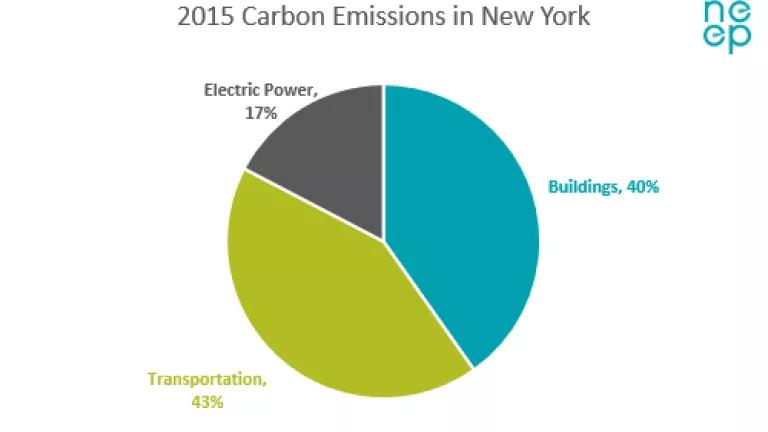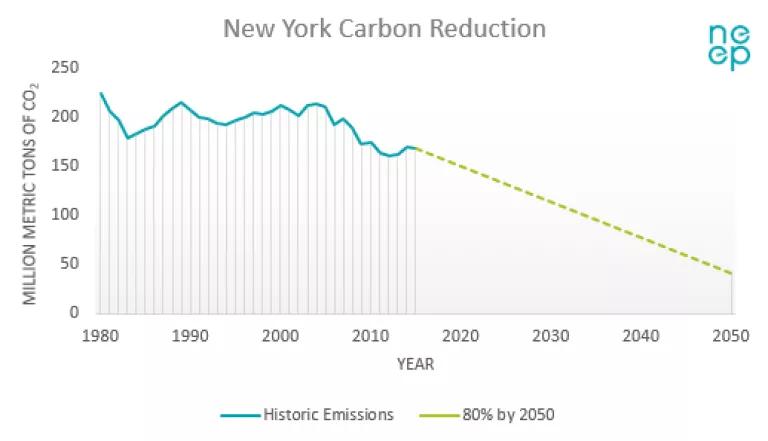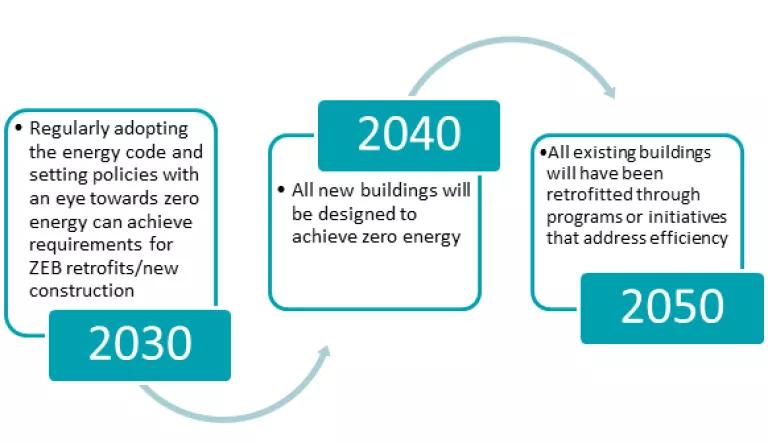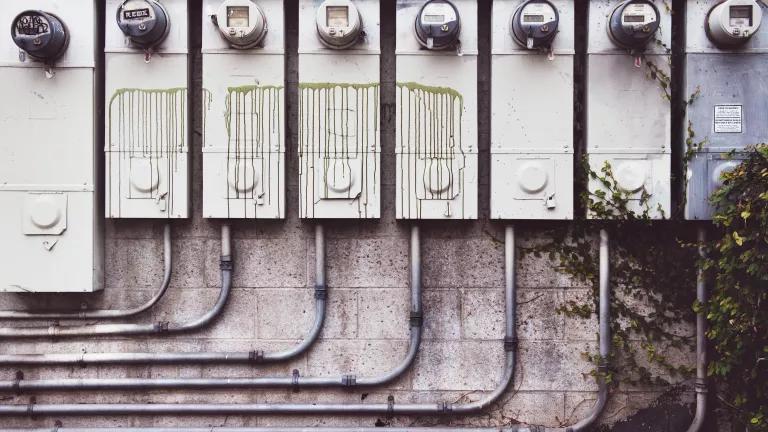Building Energy Codes Can REV Up NYS Energy Efficiency

This blog was authored by Samantha Caputo, Policy and Research Associate at Northeast Energy Efficiency Partnerships (NEEP).
Updating the building energy codes in New York and including a plan for zero-energy buildings in the broader energy efficiency framework will help the state exceed its goals under its Reforming the Energy Vision (REV) strategy and set the state on the path toward an 80 percent reduction in carbon emissions by 2050.
Governor Andrew Cuomo kicked off the year with the 2018 State of the State, in which he promised the establishment of an energy efficiency savings target by Earth Day. Building energy codes will be a critical tool in achieving this target. With related training and support, building codes will drive higher performance building practices throughout the construction industry, influencing and improving standard practice. They will also increase the comfort and efficiency of the building sector in New York.
New York has the opportunity to use energy efficiency as a way to achieve the state’s carbon reduction goals by setting an aggressive target on par with states like Massachusetts and Rhode Island (which achieve roughly 3 percent energy savings each year). In 2016, New York achieved energy savings equal to 1.09 percent of annual utility electricity sales, but the state’s forthcoming energy efficiency framework provides an opportunity to save much more.
Energy efficiency is the cheapest way to reduce harmful carbon pollution emissions, which is critical for New York to reach its goal to achieve 80 percent carbon reduction by 2050. In New York, the built environment accounts for 40 percent of carbon emissions. This presents a chance to drastically reduce carbon through significant gains in energy efficiency—through retrofits and other measures and practices that improve the efficiency of existing buildings and stronger building energy codes to make sure newly constructed and renovated buildings don’t waste energy. The energy efficiency savings target to be announced will also help achieve the 2030 goals under REV, including a 23 percent decrease in energy consumption from buildings from 2012 levels and ensuring that 50 percent of our electricity comes from renewable sources.
New York currently uses the 2015 International Energy Conservation Code (IECC), with NY amendments for residential buildings and the 2015 IECC and 90.1-2013 ASHRAE with NY amendments for commercial buildings. The 2018 IECC and 90.1-2016 ASHRAE were recently released. A number of states, including Maryland, Massachusetts, and Illinois, are statutorily obligated to adopt the newest version of the IECC within one year of publication. New York should also consider this type of “automatic” update, which ensures predictability for builders and helps drive even higher levels of efficiency. Vermont, D.C., New Jersey, Delaware, and Massachusetts are also looking toward adopting the 2018 IECC or amending the 2015 IECC to be more efficient than the 2018 IECC. New York should adopt the new code with strengthening amendments toward zero energy, solar-ready buildings and standards that help accelerate electric vehicle deployment and carbon reduction. The State Fire Prevention and Building Code Council already meets at least four times a year to consider revisions to the code.

New York can adopt various strategies to advance building codes, including establishing a plan for zero-energy building codes, expanding code compliance infrastructure, implementing a stretch code (basically, a building codes strategy that allows local governments to implement a more stringent energy code than what the state has in place), allowing utility program administrators to claim savings for code compliance support activities, and more. According to NEEP’s recently published report, Building Energy Codes for a Carbon Constrained Era: A Toolkit of Strategies and Examples, these strategies will better position New York to achieve the following objectives:
- Advance building energy code development and adoption to enact zero-energy buildings codes within the next 15 to 25 years;
- Improve the administration of building energy codes to ensure that desired performance levels are realized.
The results of efficient code changes include lower utility bills, increased durability, and healthier working, learning, and living conditions in both new and renovated buildings. Advancing energy codes over time to make buildings more efficient is one of the most cost-effective and impactful strategies for reducing the state’s energy use and, thus, carbon emissions. New York can use building codes to achieve steady progress through 2050.

When looking toward a comprehensive energy efficiency plan and new energy-savings targets, New York should consider working towards zero-energy buildings (ZEBs). ZEBs are a worthwhile goal that achieve the triple bottom line (environment, society, and economy). They do not emit additional carbon during their operation, but support continued economic and population growth with no atmospheric pollution impacts from building operation. Zero-energy is achieved through optimized efficiency from renewable energy generated onsite or purchased offsite that equals the building’s annual energy consumption. As a part of working towards zero-energy buildings, New York should also consider the 2050 goal of retrofitting all existing buildings through programs or initiatives that address efficiency.
In addition, ZEBs promote the health and wellbeing of occupants with improved indoor air quality, are more durable and require less maintenance, have a higher resale value, and require a lower cost of operation and ownership. The towns of Southampton and East Hampton, New York have committed to being zero-energy communities.
ZEBs can be incorporated into a stretch code. NYSERDA (New York State Energy Research and Development Authority) recently drafted “NYStretch Code – Energy 2018” with the goal of providing opportunities to go significantly beyond the base code, regardless of the latest available code (2015 or 2018). "NYStretch" aims to provide a straightforward, flexible approach to achieving a 20 percent boost in energy savings beyond code for residential, commercial, and multifamily buildings. NYSERDA plans to draft a 40 percent and ZEB stretch code, as well.
New York City (NYC) also has a major stake and plays an important role in helping the state achieve its greenhouse gas reduction goals. With various clean energy and climate-related local laws of its own, NYC has led the way on local energy efficiency efforts, starting with the Greener Greater Buildings Plan, adopted in 2009, which required building energy benchmarking with Local Law 84, as well as periodic audits, retro-commissioning and other measures. Buildings in New York City must be designed and constructed according to the New York City Energy Conservation Code (NYCECC), which is comprised of local laws and the Energy Conservation Construction Code of New York State (ECCCNYS). By state law, local government energy codes, such as those in NYC, must be more stringent than the ECCCNYS. The NYCECC was updated in 2016, based on the 2015 IECC and ASHRAE 90.1-2012—as modified by the ECCCNYS and adopted as Local Law 91 of 2016. In addition, in December 2017, the NYC Council adopted legislation (Local Law 32 of 2018) that requires the Department of Buildings (DOB) to submit amendments to the NYCECC due to the Council in 2019 and 2022 that match the most recent New York state stretch code; if those stretch codes aren’t in place in accordance with the local legislation, DOB must propose a code that averages 20 percent energy savings over today’s code. Thus, the stringency of the state code and the elements of the NYStretch Code are directly tied to the reach of the NYCECC.
Code compliance is also a crucial component of a strong energy code. New York City has the TR8: Technical Report State of Responsibility for Energy Code Inspections form that can be utilized for third-party energy code verification. It also conducts random audit inspections of third-party inspectors to assure quality inspections.
At the state level, establishing a code collaborative to bring together diverse stakeholders may help strengthen code compliance. The collaborative could focus on how to make adoption of a strong code most successful by identifying barriers to compliance and developing mechanisms to help local officials enforce the code. Having a strong energy code on paper is not enough to ensure savings. Rigorous compliance will allow the state to accurately claim energy savings based on building energy code attribution.
Strengthening New York State’s building energy codes—including moving toward zero-energy buildings—and taking effective steps to ensure compliance play a key role in the achievement of New York’s clean energy and climate goals and should be a high priority as the state develops its comprehensive energy efficiency framework.
For technical assistance and access to NEEP’s resources on building codes, visit NEEP’s website!



